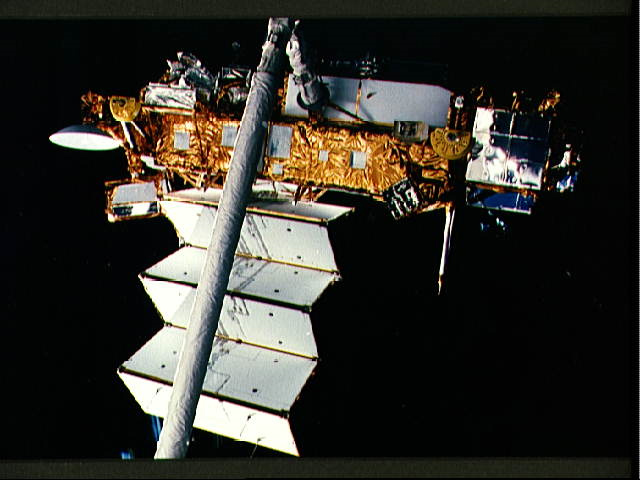Huge Defunct Satellite Falling to Earth Faster Than Expected, NASA Says

Editor's Note: See the latest on the UARS satellite re-entry as of Sept. 19 here - NASA: Huge Defunct Satellite Will Fall to Earth This Week
This story was updated at 3:30 p.m. ET.
NASA space junk experts have refined the forecast for the anticipated death plunge of a giant satellite, with the U.S. space agency now predicting the 6 1/2-ton climate probe will plummet to Earth around Sept. 23, a day earlier than previously reported.
The defunct bus-size spacecraft is NASA's Upper Atmospheric Research Satellite (UARS), which launched in 1991 and was shut down in 2005 after completing its mission. The satellite was expected to fall to Earth sometime this year, with experts initially pegging a weeks-long window between late September and early October, then narrowing it to the last week of this month.
That window, NASA now says, has been trimmed to just three days.
"Re-entry is expected Sept. 23, plus or minus a day. The re-entry of UARS is advancing because of a sharp increase in solar activity since the beginning of this week," NASA officials wrote in a status update today (Sept. 16). The projection is a day earlier than a previous forecast released by NASA yesterday.
NASA spokeswoman Beth Dickey confirmed with SPACE.com earlier today that the reason UARS is expected to fall early in its re-entry window is because of the sharp uptick in solar activity. Solar effects from the sun can create an extra drag on satellites in space because they can heat the Earth's atmosphere, causing it to expand, agency officials have said. [Photos: Space Debris & Cleanup Concepts]
Breaking space news, the latest updates on rocket launches, skywatching events and more!
Where will UARS fall?
But exactly where the UARS spacecraft will fall is still unknown.
NASA expects at least 26 large pieces of the massive satellite to survive the scorching temperatures of re-entry and reach Earth's surface. Titanium pieces and onboard tanks could be among that debris, but the UARS satellite carries no toxic propellant (NASA used up all the fuel in 2005).
The debris is expected to fall over a swath of Earth about 500 miles (804 kilometers) long, NASA officials said. [Video: Where Could UARS Satellite Debris Fall?]
There is a 1-in-3,200 chance of satellite debris hitting a person on the ground, odds that NASA says are extremely remote. Outside experts agree.
"Look at how much of Earth is covered with water," Victoria Samson, the Washington Office Director of the Secure World Foundation, an organization dedicated to the peaceful use of outer space, told SPACE.com this week. "There's a really good chance it's going to go straight into the ocean."
Constant satellite watch
NASA officials expect the UARS satellite to fall over a region somewhere between the latitudes of northern Canada and southern South America, which leaves a vast swath of the world open as a possible re-entry point. About 75 percent of the Earth's surface is covered in water, which makes an ocean splashdown likely, NASA and experts have said.
NASA and the Joint Space Operations Center of U.S. Strategic Command at Vandenberg Air Force Base, Calif., are keeping a close watch on the falling satellite, but will only be able to pinpoint its actual crash zone to within about 6,000 miles (10,000 km) about two hours before re-entry.
As of Thursday, the UARS satellite was flying in an orbit of between 143 and 158 miles (230 to 255 km) above Earth. That orbit is dropping lower each day, NASA officials said. [Infographic: NASA's Falling UARS Satellite Explained]
NASA has advised the public not to touch any debris that may reach the surface, should it be discovered. Instead, the space agency says that anyone who finds satellite debris should contact their local law enforcement agency.
The $750 million UARS mission was designed to measure ozone and other chemical compounds found in Earth's ozone layer in order to better understand how the upper atmosphere affects our planet. It also recorded wind speeds and temperatures in the stratosphere, as well as the energy Earth received from the sun.
To follow NASA's UARS satellite updates, click here.
This report was updated to reflect new estimates of the UARS re-entry released by NASA after this story first appeared.
Senior writer Clara Moskowitz contributed to this report. You can follow SPACE.com Managing Editor Tariq Malik on Twitter @tariqjmalik. Follow SPACE.com for the latest in space science and exploration news on Twitter @Spacedotcom and on Facebook.

Tariq is the award-winning Editor-in-Chief of Space.com and joined the team in 2001. He covers human spaceflight, as well as skywatching and entertainment. He became Space.com's Editor-in-Chief in 2019. Before joining Space.com, Tariq was a staff reporter for The Los Angeles Times covering education and city beats in La Habra, Fullerton and Huntington Beach. He's a recipient of the 2022 Harry Kolcum Award for excellence in space reporting and the 2025 Space Pioneer Award from the National Space Society. He is an Eagle Scout and Space Camp alum with journalism degrees from the USC and NYU. You can find Tariq at Space.com and as the co-host to the This Week In Space podcast on the TWiT network. To see his latest project, you can follow Tariq on Twitter @tariqjmalik.

